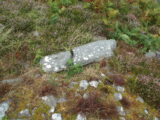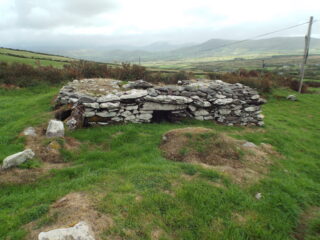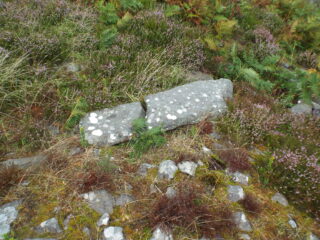Cathair na gCat Ogham Stone – Ballywiheen
An Ogham Stone, once thought to contain gold
Unguided sitesFógra
WARNING: It should be noted that these sites are unguided and a level of care and caution should be maintained during all stages of your visit. The Office Of Public Works (OPW) will not be held responsible for any damages, injuries, or losses that occur
Cathair na gCat Ogham Stone – Ballywiheen
The Ballywiheen Ogham Stone – known in Irish as Clóch Ogham ó Cathair na gCat (The ogham stone of the fort of the cats) is in the townland of Ballywiheen. This ogham stone was discovered in Cathair na gCat, which is a short distance south of a larger enclosure known as An Raingiléis. Most local accounts agree that the ogham stone was discovered in a position where it was being used as the lintel of a souterrain - an underground passage constructed in the early medieval period for use as a cellar for food storage, but which may also have doubled as a hidden refuge in times of crisis.
Ogham is an ancient Irish alphabet and our earliest written source for the Irish language. The ogham alphabet uses a script made of lines cut on, across or either side of a central 'stem' line. Ogham inscriptions were usually written vertically and are read from bottom to top. Ogham stones appear to have been erected either as memorials or territorial markers and usually record the name of a person with a standard formula such as: “X son of Y, member of the tribe of Z”. Although the alphabet was designed for the Irish language, a few Latin inscriptions in ogham also survive in Ireland. There are about 400 surviving ogham inscriptions. Approximately 350 of these are in Ireland with the largest number of ogham stones located in counties Cork, Kerry and Waterford. Around 50 ogham inscriptions have been discovered in Britain with ogham stones located in Wales, Scotland, The Isle of Mann and in Cornwall and western England.
The Ballywiheen ogham stone was carved from a single piece of grey-purple sandstone which originally had the inscription TOGITTACC MAQI SAGARET TOS (Togittacc son of the priest Tos...). About 1880 the stone was broken into three pieces by a group of men who mistakenly believed that there was gold hidden inside of it. Since that time the smallest fragment, with the final letters of the inscription “TOS...”, has been lost with the two larger fragments visible today.
Visit Historic Environment Viewer for more information on Cathair na gCat
Protect our Past - Click here to read about the importance of protecting our country’s unique heritage sites
This national monument is protected in accordance with the National Monuments Acts 1930 to 2014
Gailearaí
Suíomhanna cóngarach
Ionad an Bhlascaoid
An scéal a bhaineann le pobal uathúil oileánda
Timpeall 4.8 km ón
Maoin Oidhreachta Domhanda EOECNA Sceilg Mhichíl
Mainistir Oileánda ina seasamh go hard os cionn na farraige
Timpeall 43.3 km ón
Ardeaglais Ard Fhearta
Trí shéipéal mheánaoiseacha tiomanta do Naomh Breandán
Timpeall 46.6 km ón




